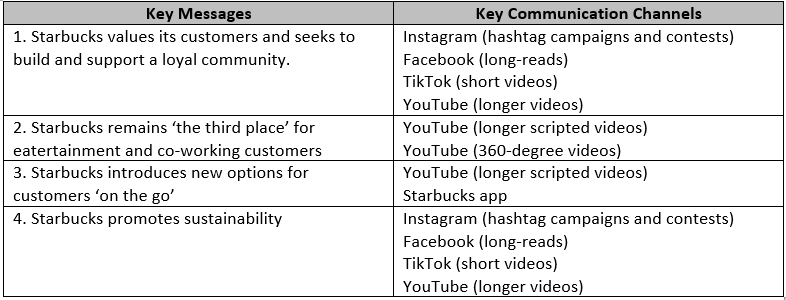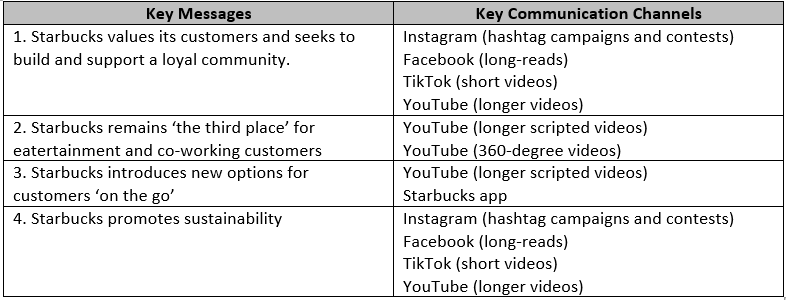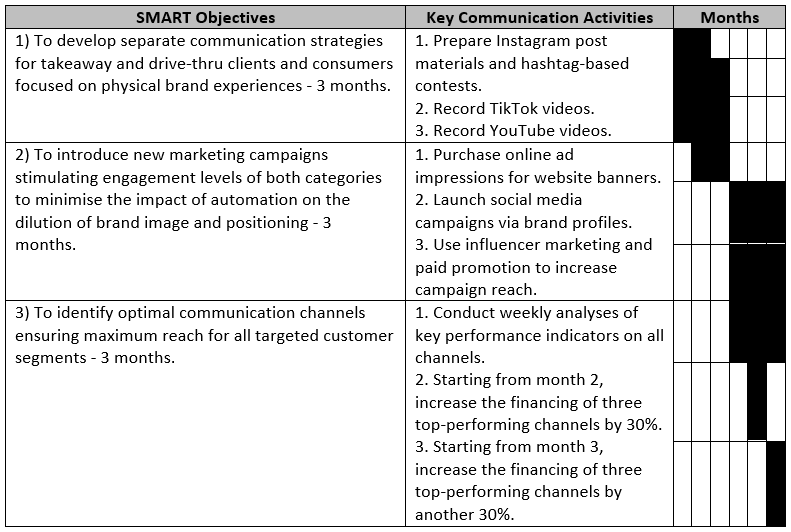Introduction
Modern marketing communication is gradually moving towards the integration of different channels, campaigns, and messages in a way where they reinforce one another and create value synergies (Juska, 2021). This trend implies the need to move away from the use of promotional instruments as isolated tools and embrace the new paradigm in which their choices are dictated by a larger strategic perspective rather than short-term goals. At the same time, this approach to integrated marketing communication requires thorough planning due to the increased complexity of alignment between the elements involved. Moreover, the speed of negative word-of-mouth emergence in both online and offline environments has increased manifold with poorly performing firms seeing adverse financial effects of their campaign failures within days rather than months (Azemi et al., 2020). This report presents a marketing communications plan for Starbucks.
Analysis of the Current Communications Material
Starbucks has a well-integrated marketing mix where Promotion, Positioning, and People elements support the Price one (Koc, 2020). The approach to communication with consumers highlights the use of the differentiation strategy where the company offers premium-quality Products in its niche with a wide range of possible choices while also creating a sense of belonging among its loyal followers. A good example of successful campaigns in this sphere is the 2015 ‘Starbucks Partner Cup Contest’ where Starbucks asked its consumers to create unique designs for its traditional white cups (Bussing, 2021). In addition to offering support and prizes to participants during the programme, the company made multiple follow-up posts in the 12 months following the event, which drew public attention to talented young designers and helped them build their personal brands as artists.
At the same time, the recent campaigns including the 2022 ‘Prize & Delight’ one did not utilise similar engagement instruments and simply offered lottery prizes for participation in the form of various Starbucks products (Forbes, 2022). Moreover, the company has recently changed several leaders and board directors due to the changing strategic course. On the one hand, its new vision involves greater use of self-serve kiosks, remote orders, and other methods facilitating takeaway orders and allowing the organisation to decrease the workloads on its staff that have been a major source of workforce complaints over the previous decade (Light, 2020). On the other hand, the introduction of these elements inevitably blurs Starbucks' positioning as ‘the third place’ focused on exclusive physical brand experiences substantiating its premium pricing.
SMART Communication Goals Based on Audit Results
As noted by Juska (2021), effective organisation goals need to be specific, measurable, achievable, relevant, and time-bound (SMART). The audit has indicated a number of key problems Starbucks needs to resolve in order to achieve the maximum effectiveness of its new marketing communications plan.
- To develop separate communication strategies for takeaway and drive-thru clients and consumers focused on physical brand experiences - 3 months.
- To introduce new marketing campaigns stimulating engagement levels of both categories to minimise the impact of automation on the dilution of brand image and positioning - 3 months.
- To identify optimal communication channels ensuring maximum reach for all targeted customer segments - 3 months.
Target Audience Identification
In terms of demographics, the main target audience of Starbucks includes young adults and medium-aged customers with medium and high income levels (Pride and Ferrell, 2018). They are willing to pay greater prices for their cold and hot beverages due to several factors. First, these clients expect high-quality ingredients and brewing techniques ensuring the superior taste of their drinks. Second, they want to enjoy a consistent level of service quality and product quality in any Starbucks restaurant they visit, which includes both respectful communication and optimal service times. Third, these consumers are environmentally conscious and are aware of the company's efforts to purchase fair trade materials, support foreign farmers, and contribute to global sustainability. Fourth, Starbucks is known to be a technology leader that was the first restaurant to offer free Wi-Fi on its premises in 2002 and develop advanced smartphone applications supporting both remote orders and loyalty programmes (Steenkamp, 2017).
From the behavioural analysis standpoint, Starbucks consumers can be subdivided into three main segments determined by their needs at a particular moment in time (Wided, 2021). The first one includes people interested in the physical brand experience determined by the old positioning of company restaurants as ‘the third place’. This allows them to relax and spend quality time between their work and home while enjoying their favourite beverages. At the same time, they may not be visiting Starbucks restaurants frequently since their main motivation is ‘eatertainment’ or getting unique guest experiences to raise their spirits. The second group are takeaway customers willing to purchase their beverages and consume them on the go (Boone et al., 2021). They may be driving to their work or having a small lunch break before proceeding with their busy schedule. These individuals may be frequent customers if they work in nearby offices or have other recurrent activities in the area. The third group includes professionals using Starbucks as a place for spending several hours with their laptops to work. They usually buy beverages and snacks and may regularly visit nearby restaurants.
Action Plan Outline
The following table shows key messages and communication channels used to support the new marketing communications plan.
Table 1: Key messages and Communication Channels
The main purpose of the new marketing plan is to balance the older company positioning as ‘the third place’ with the demand for remote orders and takeaway orders that has grown substantially during the COVID-19 period (Kelso, 2020). These two perspectives may be seen as contradictory in some areas since the premium pricing of Starbucks has been traditionally associated with its physical brand experiences. On the contrary, the automation of order processing and takeaway orders are characteristic of cheaper fast-food restaurants adhering to cost leadership and using these instruments to cut prices and eliminate employee communication with consumers as a major operational bottleneck (Walton, 2020). At the same time, the new plan has to restore the sense of company commitment to its loyal consumers that was largely lost due to generic loyalty programmes and campaigns. It needs to achieve integrated marketing communication to promote a consistent brand experience across all channels.
Choice of Key Channels
The first channel includes Instagram posts. The success of the recent #Unicorn Frappuccino campaign indicates that contests and hashtag campaigns on this platform remain a powerful way of reaching and engaging Starbucks audiences (Vassallo et al., 2018). Their use may stimulate the production of user-generated content and allow the company to openly recognise and praise the efforts of its followers. The second channel includes long-reads published on Facebook. They can explore the topics of sustainability and company positioning in greater detail to inform loyal customers about the efforts invested in reaching key goals in these spheres (Mason et al., 2021).
The third channel includes materials published on TikTok and YouTube. These two platforms favour shorter and longer videos accordingly, which suggests different patterns of their utilisation (Ge et al., 2021). TikTok materials may stimulate short-term emotional response and engagement or announce new contests in the same way as Instagram Stories and Reels. On the contrary, YouTube should be used to publish longer videos about Starbucks' advantages as ‘the third place’ as well as the new options for ‘on-the-go’ customers and its sustainability initiatives (Febriyantoro, 2020). Finally, the fourth channel includes smartphone app messages and updates. It should be predominantly used to promote new options for ‘on-the-go’ customers interested in remote orders and willing to schedule them for specific periods of time to avoid any delays (Taecharungroj, 2016).
Alignment Between Messages and Audiences/Channels
The following table summarises the alignment between the four messages discussed earlier and specific targeted audiences. It also suggests the optimal communication channels used to reach them.
Table 2: Messaging Matrix
Communications Strategy and a Marketing Calendar
Specific campaign activities associated with the earlier formulated SMART objectives will be scheduled in accordance with the following marketing calendar.
Table 3: Communications Strategy
Plan Results Measurement
To ensure the proper execution of the marketing plan, the persons responsible need to integrate a number of key performance indicators to monitor its real-time performance and identify the achievement of the earlier set goals (Kingsnorth, 2019). First, consumer engagement in terms of the number of likes, reposts, and comments should be appraised on all communication channels discussed earlier. The expected monthly increase should be set to 5%. Second, the number of views under video materials may be seen as the second critical indicator demonstrating consumer interest in Starbucks marketing messages. Intermediary analysis should identify key topics interesting to the targeted audiences and lead to the production of new content based on these themes (Duening et al., 2020). Third, sales figures for in-store and remote orders need to demonstrate a monthly increase of 5% or more during the period of the campaign. Specific baseline indicators need to be taken from previous-year figures to take into account seasonal demand fluctuations.
Conclusion
It can be summarised that the new marketing communications plan for Starbucks needs to restore the loyalty of brand customers and promote the company's commitment to its established ideals (Luck et al., 2020). This is achieved by focusing on two main consumer audiences in terms of behavioural traits. On the one hand, Starbucks needs to re-establish its positioning as ‘the third place’ that has been blurred during the COVID-19 lockdown period (Walton, 2020). On the other hand, it needs to highlight the advantages of ‘coffee on the go’ options for consumers interested in frequent repeating purchases made during their lunch breaks or other daily activities. Additionally, both of these themes should be combined with messages highlighting the recognition of community members and continued sustainability efforts (Boone et al., 2021). These elements have been partially lost by Starbucks in recent years and need to be restored in order for it to establish good marketing communication and keep its followers loyal and interested in the brand.
References
Azemi, Y., Ozuem, W. and Howell, K. (2020) “The effects of online negative word‐of‐mouth on dissatisfied customers: A frustration–aggression perspective”, Psychology & Marketing, 37 (4), pp. 564-577.
Boone, L., Kurtz, D. and Canzer, B. (2021) Contemporary Business, Hoboken: John Wiley & Sons.
Bussing, M. (2021) Starbucks, Santa Barbara: ABC-CLIO.
Duening, T., Hisrich, R. and Lechter, M. (2020) Technology Entrepreneurship: Taking Innovation to the Marketplace, New York: Academic Press.
Febriyantoro, M. (2020) “Exploring YouTube Marketing Communication: Brand awareness, brand image and purchase intention in the millennial generation”, Cogent Business & Management, 7 (1), pp. 1-20.
Forbes (2022) “Why Your Customers Are Your Company’s Identity”, [online] Available at: https://www.forbes.com/sites/forbestechcouncil/2022/04/18/why-your-customers-are-your-companys-identity/?sh=2bfc28b6774e [Accessed on 11 July 2022].
Ge, J., Sui, Y., Zhou, X. and Li, G. (2021) “Effect of short video ads on sales through social media: the role of advertisement content generators”, International Journal of Advertising, 40 (2), pp. 1-27.
Juska, J. (2021) Integrated marketing communication: advertising and promotion in a digital world, London: Routledge.
Kelso, A. (2020) “Starbucks Redefines Its ‘Third Place’ Strategy to Adapt to the Coronavirus Crisis”, [online] Available at: https://www.forbes.com/sites/aliciakelso/2020/06/10/the-coronavirus-crisis-has-caused-starbucks-to-shift-its-real-estate-strategy/?sh=67bc2899197c [Accessed on 11 July 2022].
Kingsnorth, S. (2019) Digital Marketing Strategy: An Integrated Approach to Online Marketing, London: Kogan Page Publishers.
Koc, E. (2020) Cross-cultural aspects of tourism and hospitality: A services marketing and management perspective, London: Routledge.
Light, L. (2020) “How Can Starbucks Be Starbucks in a Post-Corona World?”, [online] Available at: https://www.forbes.com/sites/larrylight/2020/05/28/how-can-starbucks-be-starbucks-in-a-post-corona-world/?sh=751d05177b11 [Accessed on 11 July 2022].
Luck, E., Barker, N., Sassenberg, A., Chitty, B., Shimp, T. and Andrews, C. (2020) Integrated Marketing Communications, Boston: Cengage Learning.
Mason, A., Narcum, K. and Mason, K. (2021) “Social media marketing gains importance after Covid-19”, Cogent Business & Management, 8 (1), pp. 1-18.
Pride, W. and Ferrell, O. (2018) Marketing, Boston: Cengage Learning.
Steenkamp, J. (2017) Global Brand Strategy: World-wise Marketing in the Age of Branding, Berlin: Springer.
Taecharungroj, V. (2016) “Starbucks’ marketing communications strategy on Twitter”, Journal of Marketing Communications, 23 (6), pp. 552-571.
Vassallo, A., Kelly, B. and Zhang, L. (2018) “Junk Food Marketing on Instagram: Content Analysis”, JMIR Public Health and Surveillance, 4 (2), pp. 54-67.
Walton, C. (2020) “3 Ways Starbucks Will Emerge from COVID-19 Stronger Than Before”, [online] Available at: https://www.forbes.com/sites/christopherwalton/2020/04/03/3-ways-starbucks-will-emerge-from-covid-19-stronger-than-before/?sh=2dacd9311844 [Accessed on 11 July 2022].
Wided, B. (2021) Youth Marketing to Digital Natives, New York: Edward Elgar Publishing.




